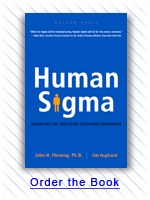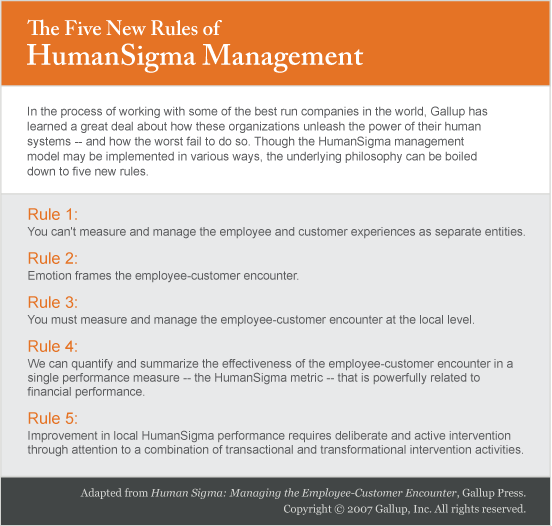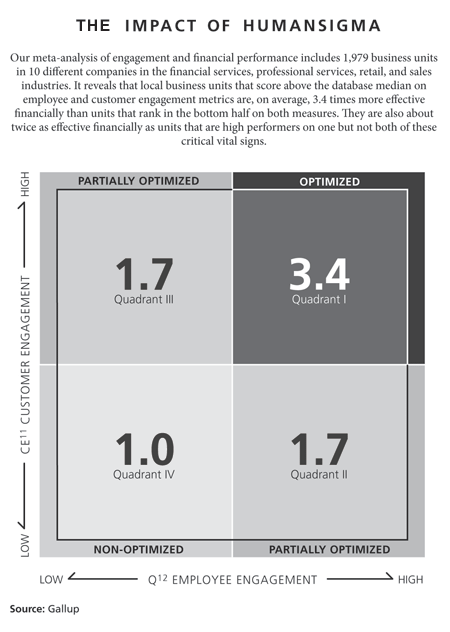Decades of research on managing the human element of business -- including interviews with more than 10 million customers and 10 million employees -- can be boiled down to the "Five New Rules of HumanSigma Management." These five rules suggest a new approach for getting the most out of those moments when your employees encounter your customers.
So say John H. Fleming and Jim Asplund, authors of Human Sigma: Managing the Employee-Customer Encounter. Their book details some of the ways the world's best performing organizations measure, manage, and improve the points of contact between their employees and their customers to drive dynamic financial performance. In this article, the fourth in a series about the five rules, we explore Rule 4: The employee-customer encounter can be quantified and summarized in a single performance metric.
Whether the Dow rises or falls, revenue shrinks, or unemployment increases, there are plenty of numbers executives must sift through during these challenging economic times. From reports to projections to analyses, leaders can immerse themselves in an expansive reserve of macroeconomic and microeconomic information.
The same holds true operationally. Organizations stake their success and develop their strategies based on a set of key performance indicators. In the plethora of acronyms, abbreviations, and raw data companies track on scorecards and "dashboards," you're likely to find numbers that gauge employee satisfaction and that reflect the quality of organizations' relationships with their customers.
But there is one number executives need to know -- one figure leaders should focus on -- that can greatly improve their organization's financial performance. It is your organization's HumanSigma metric, and it measures the interaction between your employees and their customers at the local business unit level. Tracking what Fleming and Asplund refer to as an organization's "vital signs" is key to ensuring its financial success in good times as well as in challenging ones. (See "Knowing Your Company's Vital Signs" in the "See Also" area on this page.)
So far, this series of articles -- which details several organizations' experiences with the HumanSigma performance model -- has focused heavily on the what and how of HumanSigma management. We've defined what HumanSigma is, and we've illustrated how companies from various industries have improved their business performance and financial outcomes by managing the employee-customer encounter. Now we will focus on why HumanSigma is the most accurate and effective measurement of your organization's human systems performance.
Interaction, not isolation
Gallup researchers made an accidental discovery during research for a large retailer. They found that managing and measuring the employee-customer encounter interdependently has a greater impact on the health of an organization's human systems than managing employee and customer engagement independently. "When viewed from the perspective of local business unit performance, customer and employee engagement . . . potentiate one another, creating the opportunity for accelerated improvement and growth of overall financial performance," write Fleming and Asplund.
Engaged employees create engaged customers, whose business in turn provides companies with greater financial outcomes. What companies needed, Fleming and Asplund contended, was a way to measure the complex way in which employee and customer engagement interact -- and how performance at the local business unit level affects overall organizational performance. "Integrating the vital signs of employee and customer engagement into a single performance construct supported by a single performance measure -- the HumanSigma metric -- provides a comprehensive means to capture and understand this dynamic system," they write.
As the authors explain via the fourth rule of HumanSigma, the synergy that comes from measuring and managing employee and customer engagement holistically creates a combined impact on performance outcomes that is superior to the effects of managing either part of the employee-customer encounter individually. And before readers begin to grumble, synergy -- overused corporate buzzword that it is -- does perfectly describe the interaction between employee and customer engagement. (See graphic "The Five New Rules of HumanSigma Management.")

The number you need to grow
The HumanSigma metric was devised during meta-analysis of more than 1,900 business units in 10 different companies in the financial services, professional services, retail, and sales industries. Gallup developed this metric to accurately measure and report the levels of employee and customer engagement in an organization at the local business unit.
Organizations can seek to replicate the success of their best performing teams -- if they measure them correctly.
What is the benefit for organizations that adopt a HumanSigma approach to managing their employee and customer relationships? Business units with the highest HumanSigma scores have revenue growth that is 5.2 times that of units with the lowest scores. Actively managing a business unit's HumanSigma score offers a high potential for return on investment, because most of the financial gains come from within and are less risky than other investments.
"Organizations that have adopted HumanSigma measurement systems . . . have outperformed their largest peers by 26% in gross margin and 85% in sales growth over a prior one-year period," the authors write, when comparing the study of the employee-customer encounter to more traditional measures. By measuring local units' HumanSigma scores, identifying top-performing units, and recreating the effective actions of those units with groups that have lower scores, organizations can realize revenue growth.
Gallup has found that "optimized" business units -- those that score above the median levels of employee and customer engagement -- are 3.4 times more effective financially than non-optimized units, or those with scores in the bottom half on employee and customer engagement. Optimized units also are 1.7 times more effective financially than partially optimized units, which are better than average in either customer or employee engagement but not both. (See graphic "The Impact of HumanSigma.")

Once these units attain optimized status, they must maintain performance or risk losing the gains they've made. And that's where measuring engagement at the local levels of an organization can make a difference. In their research of a multitude of companies, the authors note that the "performance gains from HumanSigma improvements tend to come from innumerable small gains in everyday performance that accumulate at the local level, rather than in large, identifiable chunks. The myriad small improvements made by the engaged work teams result in an exponential increase in output."
Economic conditions are always beyond an organization's immediate control. But leaders and managers can focus on their HumanSigma metric when working to optimize their organizations' financial performance. Organizations can learn from their best performing teams and seek to replicate their success -- if they measure them correctly. You won't find this number in the stock market scrolls or in voluminous government economic reports. The more accurate measure of your company's health -- and of its employee-customer encounters -- is its HumanSigma score. And if you don't know it, you're likely leaving money on the table.